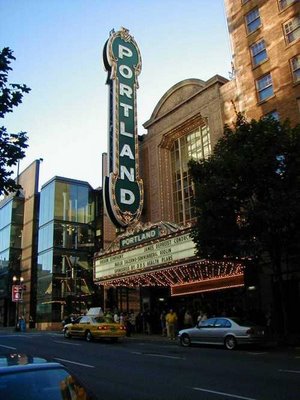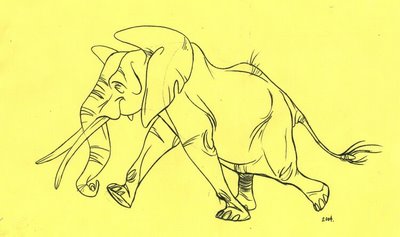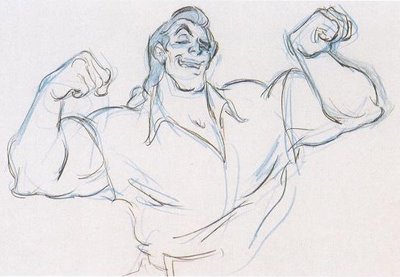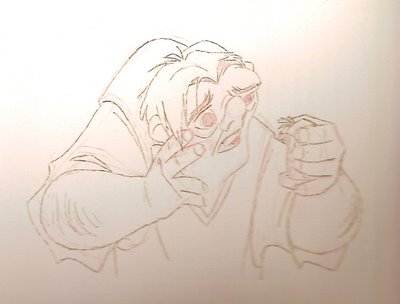In preparing this post I kept thinking, "
ahhhh man I could be preparing this post for a year before i feel like I have something that does justice to the topic." So, I feel like what would be best is if I just break this topic down into post's and sessions. This first post will be about construction (how the eye is put together) and the general errors I see a lot in drawing eyes. The first thing for anyone to do who wants to really understand what they are drawing is to study the object
thoroughly right!? You might be able to draw something from memory well, but unless you've got that
reference and real life study in your brain it'll probably lack authenticity. Eyes are
definately MY favorite part of animating close ups or medium shots. They give the term "working within the pose" a lot more meaning to me and open a lot of acting doors. The goal isn't to match life but to caricature it-- just like always in animation. There an authenticity to eyes that can be found though, one that seems to trigger something subconscious in us where our brains say " hey, I've seen that before." It can only help cross that barrier in the mind of "I know this is just a pile of drawing in some
wear house to, man I am really understanding what that character is feeling".
In studying animated eyes I've found something really interesting-- I can't find one shot where any of the 9 old men did any eye darts. I am certainly not saying that their work was less because of it, but I think it's interesting that it's used more today and not really at all back then. If anyone can think of any examples I am missing from the 9 old men era that i am forgetting please let me know. Anyway, that's sidetracking. So, eye construction... I think it's important to know how the eye ball works within the socket, how far back it is in your head, how the muscles work. What I think is less important is all the inner workings (blood vessels, etc...) though not without value.

I think the first thing to note from the picture above is that the eye ball is NOT a perfect circle. Why? Because of the lense in front of your pupil. Check out the drawing below.

I don't necessarily always draw the
lense, but I do draw the
affects of it. Meaning, because your eye is not a perfect sphere there is friction on your eye lids. Your bottom and top lid with deform and bend slightly to the curve of your
lense.
Below here in this pic see how the curve of the lid's follows the direction of the pupil. Not only is it what is physically accurate, but it also creates interest in the shape of the eye. A very basic drawing/design rule is uneven shapes. It's a very simple way to create dynamics, tension, a feeling of movement and life.

Speaking of pupil direction, check out this page below. In extreme
up or down shots (imagine the eye is in a general looking straight position) how you draw the eye is important.
Remember that the pupil and
cornea are not
on the surface of the lens. It's
beneath the
lens. If you flip your eye from the right to left rows you'll see the difference between a pupil that is "painted" on a flat surface verses the pupil that is set beneath the
lens. You'll notice on the profile I didn't draw the
literal lens sticking out from the eye. It's a matter of
taste/and style sometimes.

As I said before a basic design and drawing rule is to keep your shapes a-symmetrical . This creates interest in your shape. In this case below make sure your shapes are not straight and boring, but also that the pupil direction is reflected in the overall shape of the eye.

This pic below is just to show you where and how the muscles connect to the eye. This is more important to inform how you animate your eyes than it is how you draw them. Notice how short those muscles are? Short muscles mean quick contraction which translates into eye darts. That's why your eyes move so fast. The eyes can move slowly, but it's not as often. Like everything, it's a matter of
taste in the moment of choice.

Lastly, the thing to know about eyes is that their shape is created by the lids surrounding the eye ball. Not the eye ball itself... check out these pics of different people and note what kind of impression they give you as a viewer based on their shape.








I cannot communicate how important eyes are. Yeah yeah, we all know that you say, but really man! If they are the first thing we look at they must say some something pretty important to us as people. A lot of what I covered today was more on the technical "how to" end of things, but you gotta know this stuff to get to the artful parts of it all. Next post I'll post some screen shots from live action and animated performances that I feel uses eyes to their potential. Until then, thanks for hanging in there and reading all of this!




 I don't necessarily always draw the
I don't necessarily always draw the 

 This pic below is just to show you where and how the muscles connect to the eye. This is more important to inform how you animate your eyes than it is how you draw them. Notice how short those muscles are? Short muscles mean quick contraction which translates into eye darts. That's why your eyes move so fast. The eyes can move slowly, but it's not as often. Like everything, it's a matter of
This pic below is just to show you where and how the muscles connect to the eye. This is more important to inform how you animate your eyes than it is how you draw them. Notice how short those muscles are? Short muscles mean quick contraction which translates into eye darts. That's why your eyes move so fast. The eyes can move slowly, but it's not as often. Like everything, it's a matter of 












 Generally when i do eye darts, especially in conversation bits, I dart them back and forth from left to right. If the character is right handed I start on the other characters right eye and work to the left and back again. If the character is left handed I will do the exact opposite--
Generally when i do eye darts, especially in conversation bits, I dart them back and forth from left to right. If the character is right handed I start on the other characters right eye and work to the left and back again. If the character is left handed I will do the exact opposite--










